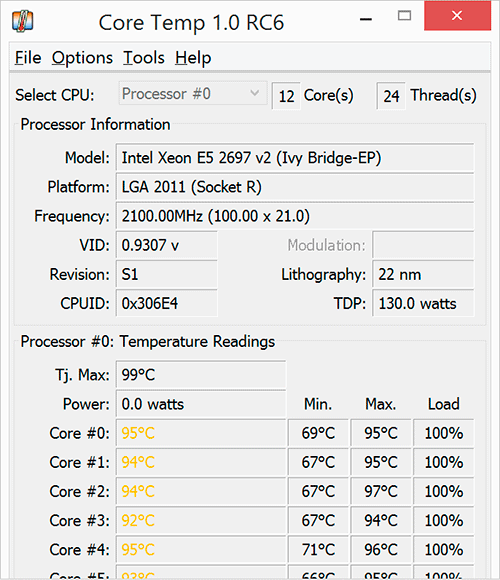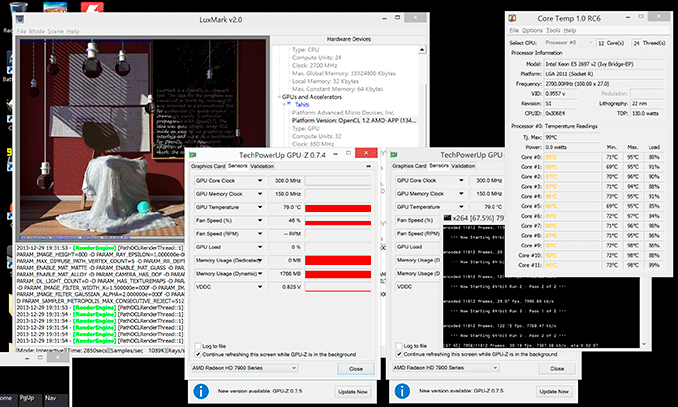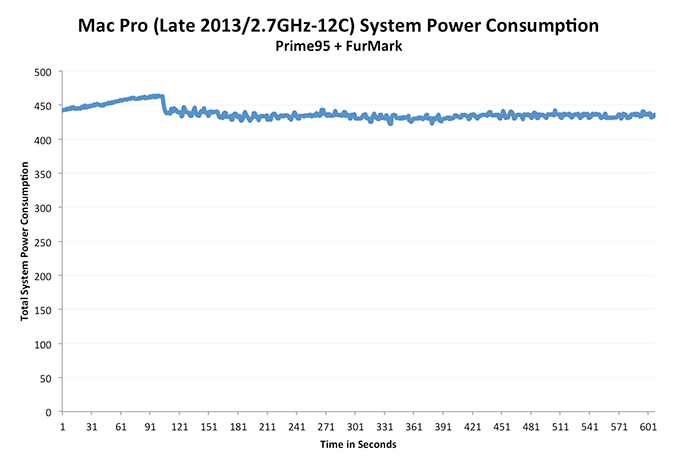The Mac Pro Review (Late 2013)
by Anand Lal Shimpi on December 31, 2013 3:18 PM ESTPower Consumption & Noise
The Mac Pro’s thermal core makes a lot of sense from an area efficiency standpoint as the chances that you have all three processors in the system (Xeon CPU + dual AMD FirePro GPUs) running at max speed at the same time is highly unlikely. By having all three players share one large heatsink Apple can optimize for the most likely usage scenarios where at most one processor is running at close to max TDP. From the moment the system was introduced however I was curious to see if its thermal design could deal with all three processors going full tilt. I decided to test both scenarios out.
The vast majority of the time the Mac Pro’s single fan spins at a paltry 769 RPM. At this speed the Mac Pro is virtually silent. I have a Promise Pegasus R6 Thunderbolt chassis with four 3.5” 7200 RPM hard drives inside. The Pegasus sits four feet away from my Mac Pro and at idle the hum of its drives drowns out the idle fan noise of the Mac.
Even running heavily threaded CPU benchmarks does nothing to impact fan speed. It's not until you run a prolonged workload that you can hear an increase in noise from the Mac Pro. I ran FurMark under OS X in parallel with a relatively heavy 4K render in Final Cut Pro. I was rendering a 20 minute 4K project with two effects applied across the entire timeline. The basic render used up 4 - 8 threads, while the effects ensured the compute GPU had some work to do. FurMark obviously kept the display GPU busy. After around 25% of the rendering task was complete the Mac Pro’s fan smoothly scaled up to 1400 RPM, then 1600 RPM and finally stopping at what I believe is full speed: 1900 RPM.
I crudely measured noise sitting at my desk, approximately 18” away from the Mac Pro at all of these points:
| Mac Pro (Late 2013) Fan Noise vs. RPM | ||||||
| Fan Speed (RPM) | Measured Sound Pressure Level @ 18" | |||||
| Off | 32.2 dBA | |||||
| 770 RPM | 32.4 dBA | |||||
| 890 RPM | 32.8 dBA | |||||
| 1097 RPM | 34.1 dBA | |||||
| 1193 RPM | 35.2 dBA | |||||
| 1440 RPM | 38.6 dBA | |||||
| 1500 RPM | 39.4 dBA | |||||
| 1900 RPM | 44.7 dBA | |||||
System noise isn’t an issue the vast majority of the time. Even if you’re running for short bursts with everything cranking away on a problem. It’s only under prolonged use of the CPU + both GPUs that the fan has to spin up this high. I quit FurMark and kept the FCP render going, which brought system power down from ~380W to ~326W. It also slowly dropped fan speed from 1900 RPM down to 1500 RPM before smoothly alternating between 1200 RPM and 1450 RPM. The way the Mac Pro’s fan ramps is actually just as important as its ability to remove heat. There are no dramatic increases in speed, just an incredibly smooth curve that the Pro’s fan moves up and down.
The system never gets annoyingly loud, it just varies between silent and calmly reminding you that there’s a large fan inside. Even at full bore the Mac Pro’s fan noise is more pleasant than harsh. It’s not magic, just good system design coupled with the fact that even with a pair of D700s Apple went a bit conservative on GPU speed. Had this been a system capable of pulling 800W at the wall, we’d be having a different discussion about noise.
My next task was to see what actually happens in this worst case scenario. If you’re running all of the parts at full tilt, are any of them going to throttle? I have to work pretty hard to get the fan to spin up under OS X, but in Windows it’s a lot easier since I can just toss a single multi-GPU workload at the problem.
I started out by running LuxMark, an OpenCL workload, on both GPUs as well as a multithreaded 7-Zip benchmark on all of the CPU cores. I monitored both CPU and GPU frequencies. The result was no throttling across the board:
Getting an accurate reading on GPU frequencies from Tahiti based GPUs ends up being harder than I expected, but I saw what Ryan reminded me is typical behavior where the GPUs alternate between their 650MHz base clock and 850MHz max turbo. We don’t have good tools to actually measure their behavior in between unfortunately.
The same was true for the CPU. Even with all 12 cores taxed heavily, I never saw any drops below the CPU’s 2.7GHz base clock.
Next I tried a heavier workload on the CPU: a H.264 video encode. Here I just ran the x264 5.01 benchmark in parallel with the LuxMark workload. Once again, I saw no drop in CPU or GPU clocks although I believe I was approaching the limits of where that would hold true. The system was pulling an average of 410W at that point, with peak power draw at 429W.
If you’re wondering, there was little to no impact on the x264 benchmark from having LuxMark run in the background. The first rendering pass took about a 3% hit, likely due to the CPU not being able to turbo as high/at all, but the second heavily threaded pass was on par with my standalone run without LuxMark in the background. LuxMark on the other hand saw around a 14% reduction in performance, from 2040K samples per second down to 1750K when run in parallel with the x264 test. We’re still talking about two extremely compute intensive tasks, the fact that I can run both with little performance reduction is an example of the sort of performance scaling that’s possible if you leverage all of the compute in the Mac Pro.
So far I wasn’t surprised by the platform’s behavior. The Mac Pro’s thermal core and fan was enough to handle a real world workload without throttling. But what about a power virus? For this I ran a combination of FurMark at 2560 x 1440 and Prime95 (in-place large FFTs) across all GPUs and CPU cores.

The GPUs peaked at 97C, which is pretty much as high as a 28nm Tahiti should ever go. The CPU hit a similar temperature, with most cores hovering around 95C. GPU clocks seemed ok, with both GPUs running between 650 - 850MHz (base - boost). The CPU on the other hand dropped down to 2.1GHz (I even saw a short excursion down to 2GHz). Average power while running this workload was 437W, peaking at 463W before CPU throttling kicked in. If you plot out a graph of power vs. time you can see the CPU throttling kick in during the workload.
I have to stress that I haven’t been able to get this to happen in any normal workload, only what’s effectively a power virus for the GPUs and something quite unrealistic for the CPUs. Either way it shows us the upper limit of what the thermal core can do.
Overall power consumption is down considerably compared to previous generation Mac Pros:
| Mac Pro Power Consumption | ||||||
| Idle | Multithreaded CPU Load | |||||
| Apple Mac Pro (Late 2013/2.7GHz-12C) | 85.5W | 190.7W (Cinebench 11.5) | ||||
| Apple Mac Pro (Early 2009/2.93GHz-8C) | 125.3W | 254W (Cinebench R10) | ||||
| Apple PowerMac G5 Dual 2.5GHz | 120.8W | 252.2W (Cinebench R10) | ||||
Idle power consumption is down and power efficiency under load is way better than the early 2009 Mac Pro I have here. As far as I can tell, max power consumption for either compute system (CPU alone or dual GPUs alone) is around 300 - 320W. With both subsystems combined you'll get the 437W figure I talked about earlier.
You don't even need a power virus to get there. Running two realistic workloads that are heavy enough won't get you up to the 463W point where I saw throttling, but it'll get you close to the max average power I recorded on the Mac Pro.















267 Comments
View All Comments
damianrobertjones - Thursday, January 2, 2014 - link
"I like the new Mac Pro’s chassis a lot. It’s a risk, but one that absolutely must be taken if the desktop is to continue to exist and thrive."Absolute rubbish... Sorry. We simply DO NOT have to change the case. Sure, of course, the option of having a case like this is fantastic but simply changing the case DOES NOT enable this to 'thrive'.
AnnonymousCoward - Sunday, January 5, 2014 - link
Agreedplatinumjsi - Thursday, January 2, 2014 - link
What are you using to monitor the GPU usage? I have been looking for a app for OSX for a while without any joy?hoboville - Thursday, January 2, 2014 - link
Sigh, lots of fanboyism in the comments, without recognition that this is just a slower, more expensive PC, the only difference is that it can run OSX only programs. Here's some hardware facts:This machine is basically a dual-GPU Xeon workstation with 2x 7970 in Crossfire (D700). Nothing special. Ok, so each 7970 has 6 GB of RAM. Well, each 7970 is also underclocked...and the RAM isn't ECC, so if you want one of these workstations for serious GPU compute, you're going to be eating bit errors, and your data is going to be suspect. Real GPGPUs use ECC RAM, period. If ECC doesn't matter, then dual/triple/quad AMD GPUs of any stripe will do you fine. Even better now that R9 290(X) are out, and they have 4 GB of RAM.
What if I need more local storage than 200 GB? Most raw video is bigger than that. So your files are stored on a NAS, but this machine only has gigabit NICs. If you want to take advantage of RAID throughput for massive files, you'll need 10 Gbit. But this machine can't use 10 Gbit NICs, as there's no place to put them.
This workstation, then, isn't for serious compute, those who have big files, and it isn't for those who want to use the most powerful GPUs for rendering / modeling. That belongs to Nvidia, there are plenty of benchmarks out there attesting to that fact. You can't get Nvidia on this workstation, so what then? I guess you buy this machine for Mac-specific applications.
And that's what this machine is for--Mac OS. If you want more power, UNIX/Linux/Windows boxes are where you go (not Apple-restricted Unix either). Are they bigger? Yes. Hotter? Yes. In fashion because small = sexy? Nope. And that's what this comes down to, looks, style, sleekness, and other metrics not relevant to performance. Sure, there's a niche for those who use Mac only software, but what if you want to do more? Apple has convinced people that style and a walled garden of software is more value than function, stop wasting your money and drop OSX!
pmhparis - Thursday, January 2, 2014 - link
Snort, the ignorant NVidia hobo fanboy complains of Mac fanboys...Professionals don't store video projects on internal storage, they use DAS devices like Thunderbolt or USB3 disk enclosures.
Houston1 - Thursday, January 2, 2014 - link
Incorrect.Chirpie - Friday, January 3, 2014 - link
No, it's pretty spot on. Every video environment I've worked in does not keep the project files and assets on the machine. It's a very normal/typical way of doing business with many terabytes worth of files. I'll go one step further though and say that it's not just USB and Thunderbolt but even duplexed gigabit ethernet or optical, or a number of other flavors as well.FunBunny2 - Saturday, January 4, 2014 - link
Steve was always the best snake oil salesman since Barnum. How Apple can contend that it spends billions and billions of dollars on R&D is baffling. It can't have cost that much to devise a square cornered rectangle, or single cornered Cube. The parts, 99.44% are off the shelf from suppliers.DotFab - Thursday, January 2, 2014 - link
Many thanks for this impressive review of the MacPro 2013!!You treat every point and more I had in mind!
A huge and fine work, I really feel like I know what's the MP 2013 now.
Happy new year to AnandTech and to everyone !
HisDivineOrder - Thursday, January 2, 2014 - link
I love that Anand is discussing his well-known Apple addiction and the subsequent fanboyism he engages in. It is good. Admitting he has a problem means he can perhaps one day overcome it.One day. Today is not the day.
How can anyone in their right mind suggest buying such a limited-expandability computer for anything NOT a low-power HTPC? If you pay this much money, you really ought to be able to easily change out the GPU(s).
When you're so hooked on a company's products you're rubbing them like Gollum rubbing the Ring of Power, I think you've got to stop and take stock.